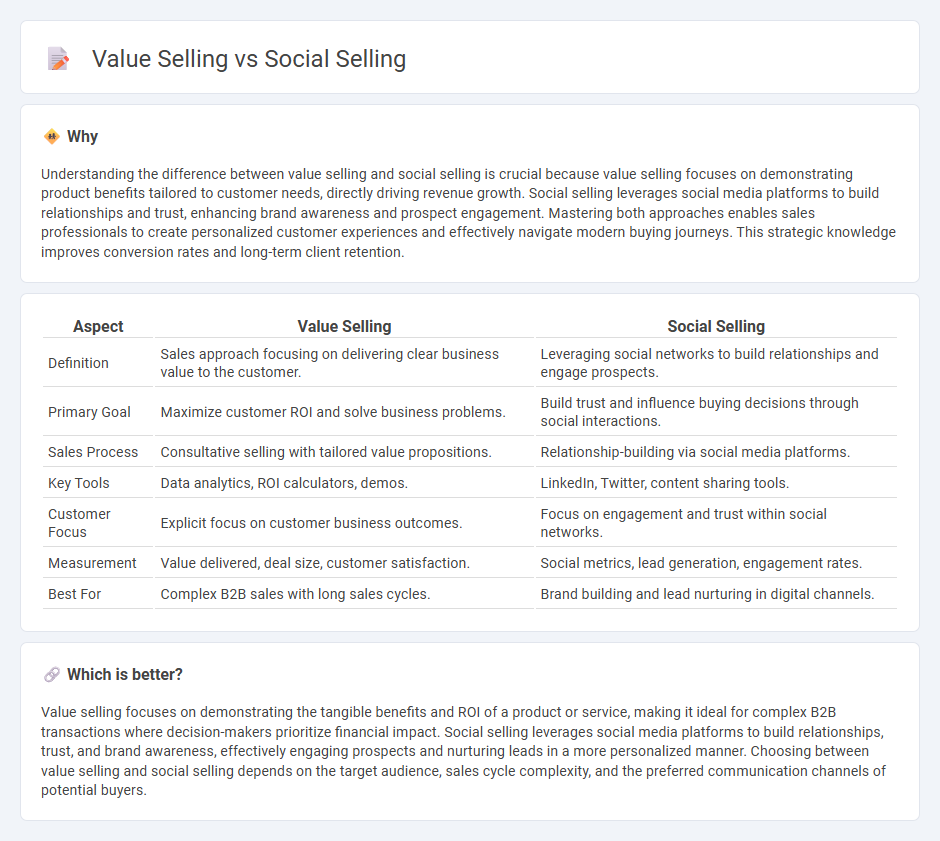
Value selling focuses on demonstrating the tangible benefits and return on investment a product or service provides to customers, emphasizing solutions tailored to their specific needs and challenges. Social selling leverages social media platforms to build relationships, engage prospects, and deliver personalized content that nurtures trust and credibility. Discover how combining value selling with social selling can transform your sales strategy and boost revenue growth.
Why it is important
Understanding the difference between value selling and social selling is crucial because value selling focuses on demonstrating product benefits tailored to customer needs, directly driving revenue growth. Social selling leverages social media platforms to build relationships and trust, enhancing brand awareness and prospect engagement. Mastering both approaches enables sales professionals to create personalized customer experiences and effectively navigate modern buying journeys. This strategic knowledge improves conversion rates and long-term client retention.
Comparison Table
| Aspect | Value Selling | Social Selling |
|---|---|---|
| Definition | Sales approach focusing on delivering clear business value to the customer. | Leveraging social networks to build relationships and engage prospects. |
| Primary Goal | Maximize customer ROI and solve business problems. | Build trust and influence buying decisions through social interactions. |
| Sales Process | Consultative selling with tailored value propositions. | Relationship-building via social media platforms. |
| Key Tools | Data analytics, ROI calculators, demos. | LinkedIn, Twitter, content sharing tools. |
| Customer Focus | Explicit focus on customer business outcomes. | Focus on engagement and trust within social networks. |
| Measurement | Value delivered, deal size, customer satisfaction. | Social metrics, lead generation, engagement rates. |
| Best For | Complex B2B sales with long sales cycles. | Brand building and lead nurturing in digital channels. |
Which is better?
Value selling focuses on demonstrating the tangible benefits and ROI of a product or service, making it ideal for complex B2B transactions where decision-makers prioritize financial impact. Social selling leverages social media platforms to build relationships, trust, and brand awareness, effectively engaging prospects and nurturing leads in a more personalized manner. Choosing between value selling and social selling depends on the target audience, sales cycle complexity, and the preferred communication channels of potential buyers.
Connection
Value selling and social selling are connected through their shared focus on building trust and delivering tailored solutions that address customer needs. Social selling leverages digital platforms to engage prospects and gather insights, enabling sales professionals to present value-driven offerings effectively. By integrating personalized interactions and value propositions, businesses enhance customer relationships and drive higher conversion rates.
Key Terms
**Social Selling:**
Social selling leverages social media platforms to build relationships, engage prospects, and nurture leads by sharing relevant content and personalized interactions. This approach emphasizes authentic communication and trust-building, allowing sales professionals to connect with buyers in a non-intrusive manner throughout the buying journey. Discover how social selling can transform your sales strategy and drive deeper customer engagement.
Personal Branding
Personal branding plays a crucial role in both social selling and value selling, enhancing credibility and trust with potential customers. Social selling leverages personal brand presence on platforms like LinkedIn to build relationships and engage prospects, while value selling emphasizes communicating the unique benefits and solutions tied to the salesperson's expertise. Explore how strengthening your personal brand can transform your sales strategy and drive more meaningful client connections.
Relationship Building
Social selling leverages online platforms like LinkedIn to connect and engage prospects through personalized interactions, fostering trust and rapport. Value selling emphasizes demonstrating tangible benefits and tailored solutions that directly address customer pain points to build long-term relationships. Explore how combining both strategies can maximize your sales effectiveness and customer loyalty.
Source and External Links
Social selling - Wikipedia - Social selling is the process of developing relationships as part of the sales process, primarily through social networks, to engage and build trust with potential buyers.
What Is Social Selling? (With Benefits and Best Practices) - Indeed - Social selling leverages sales professionals' social media profiles to generate leads and build relationships by sharing strategic content and interacting directly with prospects.
Social selling: What it is and how to get good at it - Hootsuite Blog - Social selling uses social networks to connect with, understand, and nurture leads, focusing on relationship-building and demonstrating expertise to become the go-to contact when prospects are ready to buy.
 dowidth.com
dowidth.com